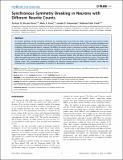| dc.contributor.author | Wissner-Gross, Zachary Daniel | |
| dc.contributor.author | Scott, Mark A. | |
| dc.contributor.author | Steinmeyer, Joseph D. | |
| dc.contributor.author | Yanik, Mehmet Fatih | |
| dc.date.accessioned | 2014-02-26T13:07:10Z | |
| dc.date.issued | 2013 | |
| dc.identifier.citation | Wissner-Gross, Zachary D., Mark A. Scott, Joseph D. Steinmeyer, and Mehmet Fatih Yanik. 2013. Synchronous symmetry breaking in neurons with different neurite counts. PLoS ONE 8(2): e54905. | en_US |
| dc.identifier.issn | 1932-6203 | en_US |
| dc.identifier.uri | http://nrs.harvard.edu/urn-3:HUL.InstRepos:11801439 | |
| dc.description.abstract | As neurons develop, several immature processes (i.e., neurites) grow out of the cell body. Over time, each neuron breaks symmetry when only one of its neurites grows much longer than the rest, becoming an axon. This symmetry breaking is an important step in neurodevelopment, and aberrant symmetry breaking is associated with several neuropsychiatric diseases, including schizophrenia and autism. However, the effects of neurite count in neuronal symmetry breaking have never been studied. Existing models for neuronal polarization disagree: some predict that neurons with more neurites polarize up to several days later than neurons with fewer neurites, while others predict that neurons with different neurite counts polarize synchronously. We experimentally find that neurons with different neurite counts polarize synchronously. We also show that despite the significant differences among the previously proposed models, they all agree with our experimental findings when the expression levels of the proteins responsible for symmetry breaking increase with neurite count. Consistent with these results, we observe that the expression levels of two of these proteins, HRas and shootin1, significantly correlate with neurite count. This coordinated symmetry breaking we observed among neurons with different neurite counts may be important for synchronized polarization of neurons in developing organisms. | en_US |
| dc.description.sponsorship | Physics | en_US |
| dc.language.iso | en_US | en_US |
| dc.publisher | Public Library of Science | en_US |
| dc.relation.isversionof | doi:10.1371/journal.pone.0054905 | en_US |
| dc.relation.hasversion | http://www.ncbi.nlm.nih.gov/pmc/articles/PMC3569465/pdf/ | en_US |
| dash.license | LAA | |
| dc.subject | Biology | en_US |
| dc.subject | Biophysics | en_US |
| dc.subject | Developmental Biology | en_US |
| dc.subject | Organism Development | en_US |
| dc.subject | Pattern Formation | en_US |
| dc.subject | Morphogenesis | en_US |
| dc.subject | Neuroscience | en_US |
| dc.subject | Cellular Neuroscience | en_US |
| dc.subject | Neuronal Morphology | en_US |
| dc.subject | Developmental Neuroscience | en_US |
| dc.subject | Axon Guidance | en_US |
| dc.subject | Neurogenesis | en_US |
| dc.subject | Systems Biology | en_US |
| dc.subject | Engineering | en_US |
| dc.subject | Bioengineering | en_US |
| dc.title | Synchronous Symmetry Breaking in Neurons with Different Neurite Counts | en_US |
| dc.type | Journal Article | en_US |
| dc.description.version | Version of Record | en_US |
| dc.relation.journal | PLoS ONE | en_US |
| dash.depositing.author | Wissner-Gross, Zachary Daniel | |
| dc.date.available | 2014-02-26T13:07:10Z | |
| dc.identifier.doi | 10.1371/journal.pone.0054905 | * |
| dash.contributor.affiliated | Wissner-Gross, Zachary Daniel | |


